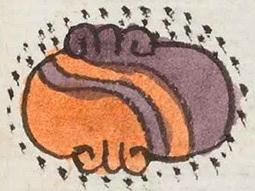poxactic (Mdz26r)
This simplex glyph for poxactic (spongy) doubles as the compound glyph for the place name, Tepoxaco. It consists of a horizontal stone with curly ends and purple and terracotta or orange curving stripes. Surrounding the stones are dots that suggest the nature of the stone, perhaps as porous, spongy, or crumbly.
Stephanie Wood
The dots suggest loose gravel, stone that is crumbly, or possibly stone that is spongy. This glyph, especially for the place name, could also be seen as a compound, given the presence of the stone and the dots indicating that it is spongy or crumbling.
See the dots that suggest a porous nature on the glyph for Tepetlapan (below).
Stephanie Wood
c. 1541, but by 1553 at the latest

poxac(tic), spongy or loose, https://nahuatl.wired-humanities.org/content/poxactic
-tic, a suffix for adjective-like substantives, https://nahuatl.wired-humanities.org/content/tic-0
spongy
Codex Mendoza, folio 26 recto, https://digital.bodleian.ox.ac.uk/objects/2fea788e-2aa2-4f08-b6d9-648c00..., image 62 of 188.
The Bodleian Libraries, University of Oxford, hold the original manuscript, the MS. Arch. Selden. A. 1. This image is published here under the UK Creative Commons, “Attribution-NonCommercial-ShareAlike 3.0 License” (CC-BY-NC-SA 3.0).


